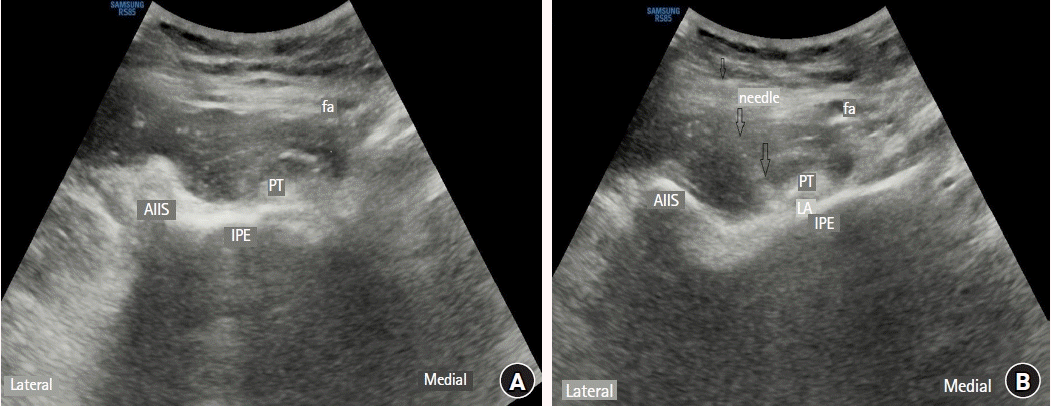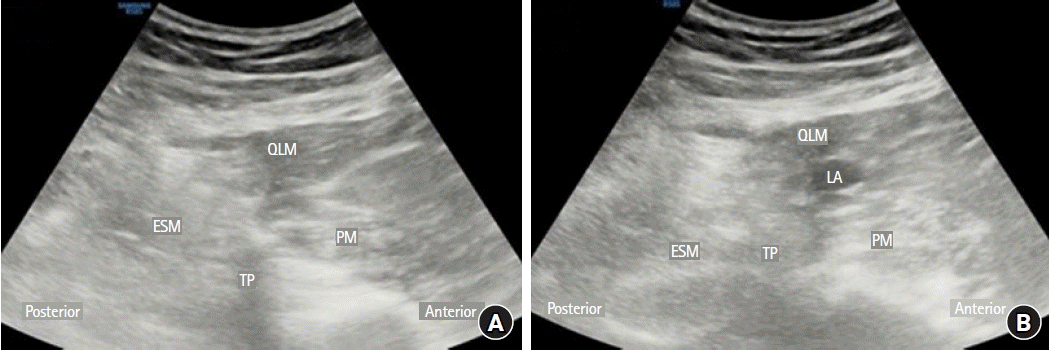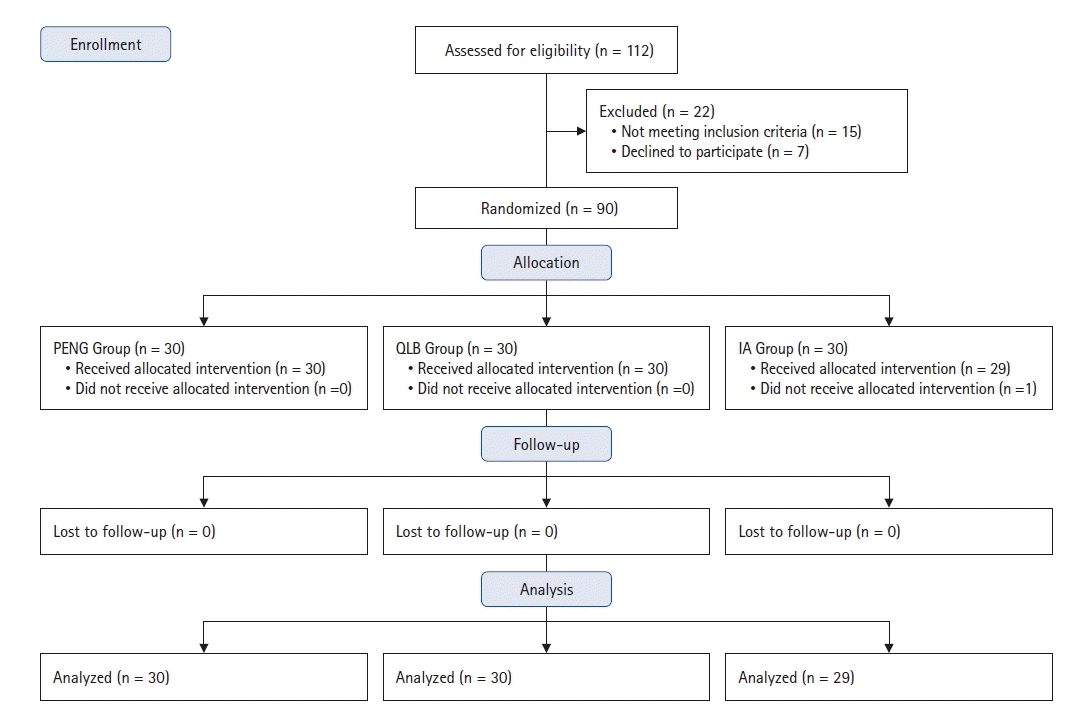1. Tran DQ, Salinas FV, Benzon HT, Neal JM. Lower extremity regional anesthesia: essentials of our current understanding. Reg Anesth Pain Med. 2019; 44:143–80.

2. Hogan MV, Grant RE, Lee L Jr. Analgesia for total hip and knee arthroplasty: a review of lumbar plexus, femoral, and sciatic nerve blocks. Am J Orthop (Belle Mead NJ). 2009; 38:E129–33.
3. Young AC, Buvanendran A. Pain management for total hip arthroplasty. J Surg Orthop Adv. 2014; 23:13–21.

4. Girón-Arango L, Peng PWH, Chin KJ, Brull R, Perlas A. Pericapsular nerve group (PENG) block for hip fracture. Reg Anesth Pain Med. 2018; 43:859–63.

5. Del Buono R, Padua E, Pascarella G, Costa F, Tognù A, Terranova G, et al. Pericapsular nerve group block: an overview. Minerva Anestesiol. 2021; 87:458–66.

6. Kaur G, Saikia P, Dey S, Kashyap N. Pericapsular nervegroup (PENG) block—a scoping review. Ain-Shams J Anesthesiol. 2022; 14:29.

7. Blanco R. 271: Tap block under ultrasound guidance: the description of a “no pops” technique. Regional Anesthesia and Pain Med. 2007; 32:130.

8. Elsharkawy H, El-Boghdadly K, Kolli S, Esa WA, DeGrande S, Soliman LM, et al. Injectate spread following anterior sub-costal and posterior approaches to the quadratus lumborum block: a comparative cadaveric study. Eur J Anaesthesiol. 2017; 34:587–95.
9. Carline L, McLeod GA, Lamb C. A cadaver study comparing spread of dye and nerve involvement after three different quadratus lumborum blocks. Br J Anaesth. 2016; 117:387–94.

10. Kukreja P, MacBeth L, Sturdivant A, Morgan CJ, Ghanem E, Kalagara H, et al. Anterior quadratus lumborum block analgesia for total hip arthroplasty: a randomized, controlled study. Reg Anesth Pain Med. 2019; 44:1075–9.

11. Blanco R, Ansari T, Riad W, Shetty N. Quadratus lumborum block versus transversus abdominis plane block for postoperative pain after cesarean delivery: a randomized controlled trial. Reg Anesth Pain Med. 2016; 41:757–62.

12. Chen DW, Hu CC, Chang YH, Lee MS, Chang CJ, Hsieh PH. Intra-articular bupivacaine reduces postoperative pain and meperidine use after total hip arthroplasty: a randomized, double-blind study. J Arthroplasty. 2014; 29:2457–61.

13. Cui Y, Yang T, Zeng C, Wei J, Xie X, Li L, et al. Intra-articular bupivacaine after joint arthroplasty: a systematic review and meta-analysis of randomised placebo-controlled studies. BMJ Open. 2016; 6:e011325.

14. Aliste J, Layera S, Bravo D, Jara Á, Muñoz G, Barrientos C, et al. Randomized comparison between pericapsular nerve group (PENG) block and suprainguinal fascia iliaca block for total hip arthroplasty. Reg Anesth Pain Med. 2021; 46:874–8.

15. Arnuntasupakul V, Chalachewa T, Leurcharusmee P, Tiyaprasertkul W, Finlayson RJ, Tran DQ. Ultrasound with neurostimulation compared with ultrasound guidance alone for lumbar plexus block: A randomised single blinded equivalence trial. Eur J Anaesthesiol. 2018; 35:224–30.
16. Pascarella G, Costa F, Del Buono R, Pulitanò R, Strumia A, Piliego C, et al. Impact of the pericapsular nerve group (PENG) block on postoperative analgesia and functional recovery following total hip arthroplasty: a randomised, observer-masked, controlled trial. Anaesthesia. 2021; 76:1492–8.

17. Adhikary SD, Short AJ, El-Boghdadly K, Abdelmalak MJ, Chin KJ. Transmuscular quadratus lumborum versus lumbar plexus block for total hip arthroplasty: a retrospective propensity score matched cohort study. J Anaesthesiol Clin Pharmacol. 2018; 34:372–8.

18. Laumonerie P, Dalmas Y, Tibbo ME, Robert S, Durant T, Caste T, et al. Sensory innervation of the hip joint and referred pain: a systematic review of the literature. Pain Med. 2021; 22:1149–57.

19. Zheng J, Pan D, Zheng B, Ruan X. Preoperative pericapsular nerve group (PENG) block for total hip arthroplasty: a randomized, placebo-controlled trial. Reg Anesth Pain Med. 2022; 47:155–60.

20. Gupta A, Sondekoppam R, Kalagara H. Quadratus lumborum block: a technical review. Curr Anesthesiol Rep. 2019; 9:257–62.

21. Dam M, Moriggl B, Hansen CK, Hoermann R, Bendtsen TF, Børglum J. The pathway of injectate spread with the transmuscular quadratus lumborum block: a cadaver study. Anesth Analg. 2017; 125:303–12.

22. Kukreja P, Schuster B, Northern T, Sipe S, Naranje S, Kalagara H. Pericapsular nerve group (PENG) block in combination with the quadratus lumborum block analgesia for revision total hip arthroplasty: a retrospective case series. Cureus. 2020; 12:e12233.

23. Jaeger P, Nielsen ZJ, Henningsen MH, Hilsted KL, Mathiesen O, Dahl JB. Adductor canal block versus femoral nerve block and quadriceps strength: a randomized, double-blind, placebo-controlled, crossover study in healthy volunteers. Anesthesiology. 2013; 118:409–15.
24. Mistry T, Sonawane KB. Gray zone of pericapsular nerve group (PENG) block. J Clin Anesth. 2019; 58:123–4.

25. Lin DY, Morrison C, Brown B, Saies AA, Pawar R, Vermeulen M, et al. Pericapsular nerve group (PENG) block provides improved short-term analgesia compared with the femoral nerve block in hip fracture surgery: a single-center double-blinded randomized comparative trial. Reg Anesth Pain Med. 2021; 46:398–403.

26. Kuru T, Olçar HA. Effects of early mobilization and weight bearing on postoperative walking ability and pain in geriatric patients operated due to hip fracture: a retrospective analysis. Turk J Med Sci. 2020; 50:117–25.

27. Kenyon-Smith T, Nguyen E, Oberai T, Jarsma R. Early mobilization post-hip fracture surgery. Geriatr Orthop Surg Rehabil. 2019; 10:2151459319826431.








 PDF
PDF Citation
Citation Print
Print



 XML Download
XML Download